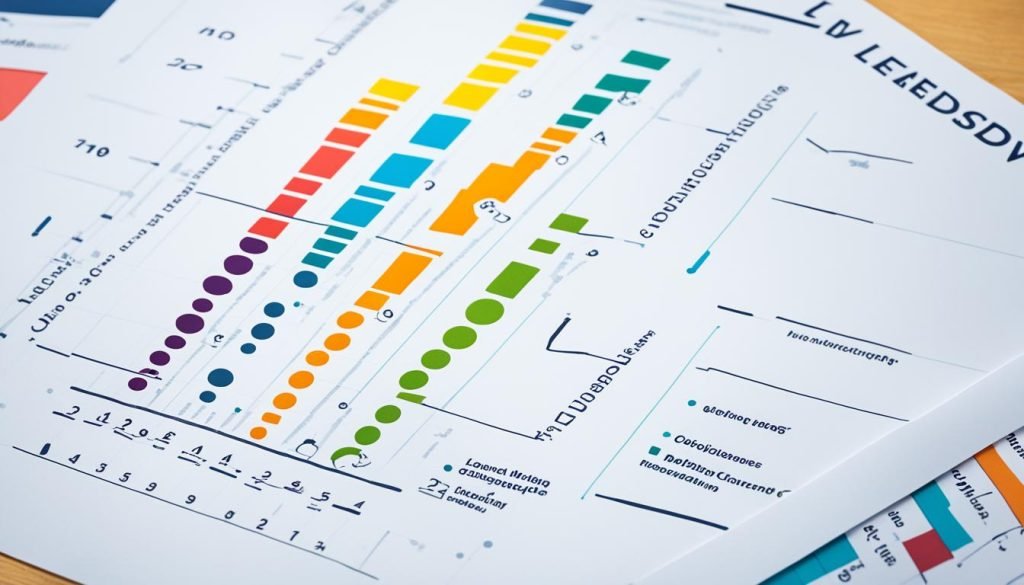What separates great leaders from the rest? Is it innate talent or something that can be developed over time? The answer lies in the realm of leadership skills development. In today’s fast-paced and competitive business world, organizations recognize the importance of nurturing effective leaders who can guide their teams towards success.
Leadership skills development encompasses a range of practices, from management training and leadership programs to executive coaching, team building workshops, and professional development seminars. These programs aim to assess and enhance individuals’ leadership abilities, equipping them with the skills and knowledge needed to navigate complex challenges, inspire others, and drive organizational growth.

Key Takeaways:
- Effective leadership is crucial for the success and growth of any business.
- Leadership skills development programs play a pivotal role in honing the necessary skills and preparing individuals to become effective leaders.
- Management training, leadership programs, executive coaching, team building workshops, and professional development seminars are some of the avenues for leadership skills development.
- Nurturing effective leaders involves assessing and enhancing individuals’ leadership abilities through various programs and practices.
- Leadership skills can be developed and cultivated over time, leading to significant benefits for organizations and individuals alike.
The Role of Leadership in Today’s School Environments
In today’s school environments, effective leadership plays a vital role in promoting educational success and creating a supportive learning environment for all students. School leaders not only need a strong knowledge of school management, finance, and legal issues but also require exceptional instructional leadership skills. They are responsible for fostering high-level learning, facilitating the personal and social development of students, and creating a compelling vision of success for all.
Effective school leaders possess excellent communication and collaboration skills, enabling them to engage with the school community and ensure that the vision becomes a reality. By effectively leading and inspiring teachers, staff, and students, school leaders can drive positive change, improve academic outcomes, and cultivate a culture of achievement.
“Effective leadership is essential for promoting educational success and creating a supportive learning environment for all students.”
Instructional leadership skills are paramount in school leadership, as they involve guiding and supporting teachers in delivering high-quality instruction. These skills encompass providing feedback, offering professional development opportunities, and facilitating a collaborative environment among educators.
In addition to their instructional leadership role, school leaders must also have a deep understanding of school management. This includes effectively allocating resources, managing budgets, implementing policies, and building relationships with stakeholders to ensure the smooth operation of the school.
Furthermore, visionary school leaders create a compelling vision of success that motivates teachers, students, and the broader school community. By articulating a clear direction, setting ambitious goals, and fostering a shared sense of purpose, they can inspire and guide others towards achieving excellence.
By prioritizing communication and collaboration skills, school leaders establish strong relationships with teachers, students, parents, and community members. Effective communication ensures that information is shared transparently, expectations are understood, and feedback is delivered constructively.
To provide a comprehensive education that meets the needs of all students, school leaders must also promote personal and social development. By creating a positive and inclusive school culture, leaders can foster social-emotional skills, develop character traits, and support the holistic growth of every individual.
Key Points:
- Effective school leadership is essential for educational success and a supportive learning environment.
- School leaders require instructional leadership skills, knowledge of school management, and a compelling vision of success.
- Communication and collaboration skills are crucial for engaging with the school community.
- Effective school leadership fosters high-level learning and personal and social development.
The Importance of Effective Leadership in Organizations
Effective leadership plays a vital role in the success of any organization. It encompasses various essential elements that contribute to achieving organizational goals and driving long-term success. Let’s explore the key aspects of effective leadership:
Vision and Goals
An effective leader sets a compelling vision and establishes clear goals for the organization. This vision provides direction and guides the efforts of the entire team towards a common purpose and shared objectives.
Mobilizing Resources
Leadership involves mobilizing and optimizing resources, both human and material, to accomplish organizational goals. This requires allocating resources efficiently, coordinating activities, and ensuring that teams have the necessary tools and support to perform at their best.
Collaborative Activities
Effective leaders foster a collaborative culture within the organization. They encourage teamwork, facilitate open communication, and promote cooperation among individuals and departments. Collaboration enhances creativity, problem-solving capabilities, and innovation.
Attracting Competent People
Competent individuals are the backbone of any successful organization. Effective leaders have the ability to attract and retain talented individuals who possess the skills and knowledge needed to drive the organization forward.
Change Management
Change is inevitable in today’s dynamic business environment. Effective leaders not only embrace change but also have the ability to manage it effectively. They guide their teams through transitions, promote adaptability, and motivate employees to embrace new ways of doing things.
Continuous Learning
Leadership is an ongoing journey of growth and development. Effective leaders prioritize continuous learning and encourage their teams to embrace a culture of learning and improvement. By staying updated with industry trends and latest practices, leaders can make informed decisions and keep the organization at the forefront of innovation.
Ethical and Moral Leadership
Integrity is a cornerstone of effective leadership. Ethical and moral leaders set high standards of conduct, lead by example, and promote fairness, transparency, and accountability. They prioritize the well-being of employees and stakeholders, making ethical decisions that uphold the values and reputation of the organization.
In summary, effective leadership is crucial for organizational success. It encompasses diverse elements, such as setting a vision and goals, mobilizing resources, fostering collaboration, attracting competent individuals, managing change, promoting continuous learning, and exemplifying ethical and moral leadership. By embodying these qualities, leaders can create a positive and thriving organizational culture that drives success and achieves remarkable outcomes.
The Need for Leadership Development Programs
In order to cultivate future leaders, organizations need to invest in leadership development programs. These programs aim to identify individuals with leadership potential and enhance their leadership skills through a variety of methods. By providing skill development, knowledge acquisition, career mapping workshops, mentorship and sponsorship connections, job shadowing, and experiential learning opportunities, leadership development programs equip individuals with the tools and knowledge they need to develop their leadership potential.
Leadership development programs play a critical role in preparing individuals to make a positive impact in their organizations. Through skill development, participants acquire the necessary competencies to navigate complex challenges and drive organizational success. Additionally, these programs focus on knowledge acquisition, ensuring that leaders have a deep understanding of their industries, market trends, and emerging technologies.
Career mapping workshops offered in leadership development programs help individuals envision their future within the organization and set clear goals for their professional growth. Mentorship and sponsorship connections provide guidance and support from experienced leaders, enabling participants to learn from their expertise and gain valuable insights into their leadership journeys.
Job shadowing is another valuable component of leadership development programs, allowing aspiring leaders to observe and learn from experienced professionals in various leadership roles. Experiential learning opportunities provide hands-on experiences where participants can apply their leadership skills in real-world scenarios, fostering growth and adaptability.
The Benefits of Leadership Development Programs:
- Identification and cultivation of leadership potential
- Enhancement of leadership skills
- Acquisition of industry knowledge and trends
- Clear career mapping and goal setting
- Guidance and support through mentorship and sponsorship
- Observation and learning through job shadowing
- Practical application of leadership skills through experiential learning
Leadership development programs provide individuals with comprehensive training and support to develop their leadership potential. These programs contribute to the growth and success of organizations by fostering a pipeline of capable and effective leaders who can drive innovation, inspire teams, and navigate challenges in today’s dynamic business landscape.
| Leadership Development Programs | Benefits |
|---|---|
| Skill development | Enhanced leadership capabilities |
| Knowledge acquisition | Deep understanding of industry trends |
| Career mapping workshops | Clear vision and goal-setting for professional growth |
| Mentorship and sponsorship | Guidance and support from experienced leaders |
| Job shadowing | Observation and learning from experienced professionals |
| Experiential learning | Practical application of leadership skills |
The Benefits of Leadership Development
Leadership development programs offer numerous benefits for both individuals and organizations. These programs empower leaders to guide teams towards success, ignite employee engagement, ensure a smooth transition of leadership, and give organizations a competitive edge.
By investing in leadership development, organizations can unlock the potential of their leaders, foster a culture of engagement and innovation, and position themselves for long-term success in a rapidly changing business landscape.
The Power of Empowerment
Leadership development programs empower individuals by equipping them with the knowledge, skills, and resources they need to take ownership of their roles and make informed decisions. This empowerment not only enhances their effectiveness as leaders but also boosts their confidence and self-esteem, enabling them to tackle challenges with resilience and determination. Empowered leaders inspire and motivate their teams, creating a positive and productive work environment.
Igniting Employee Engagement
Effective leadership is closely linked to employee engagement. Leadership development programs provide leaders with the tools and strategies to effectively communicate, collaborate, and motivate their teams. When leaders are equipped with these skills, they can create a sense of purpose among employees, foster a culture of trust and transparency, and promote a strong sense of belonging. Engaged employees are more motivated, productive, and committed, leading to higher levels of innovation and performance within the organization.
Ensuring a Smooth Transition of Leadership
Leadership transitions are inevitable within organizations. Whether due to promotions, retirements, or other factors, a smooth transition of leadership is essential to maintain organizational continuity. Leadership development programs focus not only on developing individual leaders but also on building a pipeline of leadership talent within the organization. This ensures that there are qualified individuals ready to step into leadership roles when the need arises, minimizing disruptions and maintaining the momentum of progress.
Gaining a Competitive Advantage
Leadership development programs give organizations a competitive advantage in the marketplace. By investing in the growth and development of their leaders, organizations can build a strong leadership team that is capable of making strategic decisions, driving innovation, and navigating complex challenges. Effective leadership enables organizations to adapt to change, seize opportunities, and stay ahead of the competition. In today’s fast-paced business environment, organizations that prioritize leadership development gain a significant edge in attracting and retaining top talent, achieving sustainable growth, and achieving their strategic objectives.
| Benefits of Leadership Development | Description |
|---|---|
| Empowerment | Leadership development programs empower individuals by equipping them with the knowledge, skills, and resources they need to take ownership of their roles and make informed decisions. |
| Employee Engagement | Leadership development programs enhance leaders’ ability to effectively communicate, collaborate, and motivate their teams, resulting in higher levels of employee engagement and productivity. |
| Smooth Transition of Leadership | By building a pipeline of leadership talent, leadership development programs ensure a seamless transition of leadership, minimizing disruptions and maintaining organizational continuity. |
| Competitive Advantage | Investing in leadership development gives organizations a competitive edge by building a strong leadership team capable of driving innovation, adapting to change, and staying ahead of the competition. |
Strategies for Effective Leadership Development
Effective leadership development requires the implementation of specific strategies. To cultivate tomorrow’s leaders, organizations must foster a learning environment that motivates leaders to improve their skills and embrace continuous growth. By providing a formal structure through workshops, training courses, and mentoring programs, organizations facilitate ongoing skill development for aspiring leaders.
One effective strategy is to offer career mapping workshops, which help leaders envision their future within the organization and align their goals with the company’s vision. These workshops provide clarity and direction, allowing leaders to identify the necessary skills and experiences needed for career progression.
Another vital aspect of leadership development is the implementation of leadership development programs. These programs provide structured training, mentoring, and coaching opportunities that foster growth and skill enhancement. They enable leaders to develop essential competencies, such as decision-making, communication, and strategic thinking.
Mentorship and sponsorship connections are essential components of leadership development. Pairing emerging leaders with experienced mentors and sponsors provides valuable guidance, support, and networking opportunities. This connection allows leaders to gain insights from seasoned professionals and navigate challenges more effectively.
Internal job shadowing programs are also effective in leadership development. By giving aspiring leaders the opportunity to shadow experienced professionals in various roles, organizations expose them to different leadership styles and provide hands-on learning experiences. This exposure to diverse leadership perspectives enhances their skills and widens their understanding of effective leadership.
Experiential opportunities are valuable for developing leaders’ skills and confidence. Assigning leaders to challenging projects or cross-functional teams allows them to apply their skills in practical situations and develop new competencies. These opportunities foster learning through real-world experiences, enabling leaders to gain valuable insights and enhance their decision-making capabilities.
“Leadership development is not a one-size-fits-all approach. It requires a combination of strategies tailored to the organization’s culture and the individual’s needs.” – John Maxwell
To ensure effective leadership development, organizations should tailor their strategies to create an environment that nurtures leaders and fosters a culture of continuous learning and growth.
Elements of Effective Leadership Development
| Elements | Description |
|---|---|
| Learning Environment | A supportive and inspiring environment that encourages leaders to improve their skills and embrace continuous growth. |
| Formal Structure | Workshops, training courses, and mentoring programs that provide a structured framework for skill development. |
| Career Mapping Workshops | Guidance and planning sessions that help leaders envision their future within the organization and align their goals with the company’s vision. |
| Leadership Development Programs | Structured training, mentoring, and coaching programs that enhance leaders’ competencies and skills. |
| Mentorship and Sponsorship Connections | Pairing emerging leaders with experienced mentors and sponsors to provide guidance, support, and networking opportunities. |
| Internal Job Shadowing Programs | Opportunities for aspiring leaders to shadow experienced professionals in various roles, gaining exposure to different leadership styles and experiences. |
| Experiential Opportunities | Assigning leaders to challenging projects or cross-functional teams to develop their skills and gain practical experience. |
Creating a Culture of Leadership Excellence
Organizations should strive to create a culture of leadership excellence. This involves promoting ethical and moral leadership, fostering continuous improvement, developing strong leaders, inspiring employee confidence, and nurturing existing leadership excellence. By prioritizing these aspects, organizations can create an environment that values and supports effective leadership, leading to long-term success and sustainable growth.
“Leadership is not about being in charge. It is about taking care of those in your charge.” – Simon Sinek
Effective leaders are guided by a strong ethical and moral compass, exemplifying integrity and fairness. By promoting and upholding ethical and moral leadership principles, organizations cultivate an environment of trust, transparency, and accountability.
Continuous improvement is essential for both individuals and organizations. Strong leaders continually seek opportunities for growth and encourage their teams to do the same. Embracing a culture of continuous improvement fosters innovation, adaptability, and agility, allowing organizations to thrive in an ever-changing business landscape.
The development of strong leaders is crucial for organizational success. Organizations should invest in leadership development programs, providing learning opportunities, mentorship, and coaching to nurture the leadership potential within their workforce. By developing strong leaders, organizations establish a foundation for future growth and resilience.
Inspiring employee confidence is vital for effective leadership. Leaders who empower their teams, value their contributions, and create a supportive work environment foster a sense of trust and engagement. When employees have confidence in their leaders, they are more likely to be motivated, productive, and committed to achieving shared goals.
Nurturing existing leadership excellence involves recognizing and celebrating the achievements and contributions of exceptional leaders within the organization. By showcasing and promoting leadership excellence, organizations reinforce the importance of high-quality leadership and inspire others to strive for the same level of excellence.
Key Strategies for Creating a Culture of Leadership Excellence:
- Promote ethical and moral leadership principles throughout the organization.
- Encourage continuous improvement and provide opportunities for growth.
- Invest in leadership development programs to develop strong leaders.
- Create a supportive work environment that inspires employee confidence.
- Nurture and highlight existing leadership excellence within the organization.
By prioritizing ethical and moral leadership, continuous improvement, strong leaders, employee confidence, and nurturing existing leadership excellence, organizations can cultivate a culture that fosters effective leadership at all levels. This culture of leadership excellence sets the foundation for long-term success, employee engagement, and sustainable growth.
Identifying and Nurturing Emerging Leaders
Building a strong leadership pipeline is essential for organizations to ensure future success. It requires a proactive approach to identifying and nurturing emerging leaders within the organization. By implementing effective strategies, organizations can foster the growth and development of individuals who have the potential to become influential leaders.
One crucial strategy for identifying and nurturing emerging leaders is through succession planning. This involves identifying individuals who have the skills, knowledge, and potential to take on leadership roles in the future. Succession planning allows organizations to identify high-potential employees and create a clear path for their development.
Another important tool for identifying emerging leaders is performance management systems. These systems assess the performance and potential of employees, enabling organizations to identify individuals who demonstrate strong leadership capabilities. By utilizing performance management systems, organizations can provide targeted developmental opportunities to nurture these individuals and prepare them for future leadership roles.
Furthermore, organizations can identify emerging leaders by observing talent across departments. This involves actively observing employees’ skills, attitudes, and behaviors to identify those who exhibit leadership potential. By recognizing and acknowledging talent, organizations can provide opportunities for growth and development that align with individuals’ leadership aspirations.
In addition to identifying emerging leaders, organizations should also invest in employee engagement initiatives to nurture and foster leadership potential. Employee engagement initiatives create a positive work environment that motivates and empowers individuals to develop their skills and take on leadership responsibilities. This can include mentorship programs, leadership development workshops, and opportunities for cross-functional collaboration.
By identifying and nurturing emerging leaders through succession planning, performance management systems, observing talent, and employee engagement initiatives, organizations can cultivate a strong leadership pipeline. This ensures a smooth transition of leadership and maintains a robust leadership presence within the organization, driving long-term success.
Key Points:
- Succession planning is crucial for identifying individuals with leadership potential and creating a clear path for their development.
- Performance management systems help assess employees’ performance and potential, identifying those with strong leadership capabilities.
- Observing talent across departments allows organizations to recognize individuals who exhibit leadership potential.
- Investing in employee engagement initiatives nurtures and fosters leadership potential within the organization.
Addressing the Skills Gap for Future Leaders
To ensure that future leaders are well-equipped to navigate the challenges of the business landscape, organizations need to address the skills gap. This involves conducting skills gap analyses, monitoring industry trends and competitor landscapes, and designing development programs that prepare leaders for future challenges.
Skills Gap Analysis: Organizations should conduct comprehensive skills gap analyses to identify areas for development based on the evolving needs of the organization. By understanding the gap between current and desired skills, organizations can prioritize areas for improvement and tailor development programs accordingly.
Industry Trends: It is essential for organizations to stay abreast of industry trends to anticipate the skills and competencies that will be in demand in the future. By monitoring industry trends, organizations can proactively prepare their leaders to meet the changing needs of the business landscape, ensuring future success.
Competitor Landscapes: Studying the competitor landscape can provide valuable insights into the leadership skills and competencies that are driving success in the industry. By analyzing the strategies and practices of competitors, organizations can identify emerging leadership trends and develop programs to cultivate the necessary skills in their own leaders.
Development Programs: Armed with the insights from skills gap analyses, industry trends, and competitor landscapes, organizations can design and implement targeted development programs. These programs should focus on addressing the identified skills gap and equipping leaders with the skills needed to navigate future challenges. Development programs may include leadership training workshops, mentorship programs, job rotations, and other experiential learning opportunities.
| Component | Description |
|---|---|
| Leadership Training Workshops | In-depth training sessions focused on developing specific leadership skills such as strategic thinking, communication, and decision-making. |
| Mentorship Programs | Pairing emerging leaders with experienced executives who can provide guidance, support, and opportunities for growth. |
| Job Rotations | Providing leaders with the opportunity to gain exposure to different functions and roles within the organization, broadening their skillset and perspective. |
| Experiential Learning | Engaging leaders in real-world challenges and projects where they can apply their skills and gain practical experience. |
By addressing the skills gap through skills gap analysis, monitoring industry trends and competitor landscapes, and implementing development programs, organizations can ensure that their future leaders are equipped with the necessary skills and competencies to drive long-term success.
Measuring the Effectiveness of Leadership Development Programs
When it comes to leadership development programs, measuring their effectiveness is crucial for organizations. By evaluating various metrics, organizations can assess the impact of these programs and ensure they are driving meaningful results. Key metrics for success include:
- Employee Satisfaction: Measuring the satisfaction levels of participants in leadership development programs provides valuable insights into their overall experience. It helps gauge the effectiveness of the program in engaging and inspiring participants.
- Leadership Retention: Tracking the retention rates of program participants allows organizations to determine whether the development initiatives are successful in retaining talented individuals within leadership roles. High retention rates indicate that the programs are effectively developing and nurturing future leaders.
- Promotion Rates: Monitoring the promotion rates of individuals who have completed leadership development programs provides an indication of how effectively the programs are cultivating leadership skills. Higher promotion rates among program participants demonstrate the success of the initiatives in preparing individuals for higher-level roles.
- Business Outcomes: Evaluating the impact of leadership development programs on business outcomes is essential for organizations. By analyzing key performance indicators (KPIs), such as revenue growth, profitability, and customer satisfaction, organizations can assess the direct influence of effective leadership on overall business success.
Regularly assessing these metrics allows organizations to make data-driven decisions about their leadership development programs. It enables them to identify areas for improvement, optimize strategies, and ensure that the programs align with their goals and objectives.
| Metric | Description |
|---|---|
| Employee Satisfaction | Measures the satisfaction levels of participants in the leadership development programs |
| Leadership Retention | Tracks the retention rates of program participants in leadership roles |
| Promotion Rates | Monitors the rate of promotions among individuals who have completed the leadership development programs |
| Business Outcomes | Evaluates the impact of the programs on key business performance indicators |

By utilizing these metrics, organizations can gain valuable insights into the effectiveness of their leadership development programs. They can identify the areas where the programs excel and areas that require improvement. This data-driven approach helps organizations optimize their investment in leadership development and ensure they are developing strong leaders who can drive organizational success.
Conclusion
Leadership skills development is an essential aspect of cultivating tomorrow’s leaders and driving organizational success. By investing in leadership development programs and implementing effective strategies, organizations can create a strong leadership pipeline that will propel them towards long-term growth and prosperity. Effective leadership is not just a natural talent; it can be nurtured through training, mentorship, and practical experience.
By providing individuals with the necessary tools and opportunities, organizations can foster the development of effective leaders who possess the skills and qualities needed to navigate complex challenges and inspire others towards shared goals. Through a long-term commitment to leadership development, organizations can ensure that they have a pool of talented leaders who can guide them into the future.
Tomorrow’s leaders need more than just technical expertise; they need to be equipped with strong leadership capabilities to lead teams, make strategic decisions, and adapt to changing circumstances. By prioritizing leadership skills development, organizations can create a culture of engagement and innovation, attract top talent, and gain a competitive advantage in today’s fast-paced business environment.
In conclusion, effective leadership is a key driver of organizational success. By investing in leadership skills development, organizations demonstrate their commitment to cultivating tomorrow’s leaders and positioning themselves for long-term growth and prosperity. Leadership is not just about individual qualities; it is a skill that can be developed and honed. By providing individuals with the necessary opportunities for growth, organizations can create a pipeline of talented leaders who will shape the future of their industry.
FAQ
What is leadership skills development?
Why is effective leadership important in school environments?
Why is effective leadership important for organizations?
Why do organizations need leadership development programs?
What are the benefits of leadership development?
What strategies can organizations use for effective leadership development?
How can organizations create a culture of leadership excellence?
How can organizations identify and nurture emerging leaders?
How can organizations address the skills gap for future leaders?
How can organizations measure the effectiveness of leadership development programs?
Why is leadership skills development important for cultivating tomorrow’s leaders?
Source Links
- https://education.illinoisstate.edu/downloads/isl/national-work/NY20Essential20Skills20Leadership.pdf
- https://m.economictimes.com/jobs/c-suite/leadership-development-programs-investing-in-tomorrows-leaders/articleshow/104627299.cms
- https://www.greatplacetowork.in/cultivating-the-leaders-of-tomorrow-why-leadership-development-is-a-crucial-to-do







